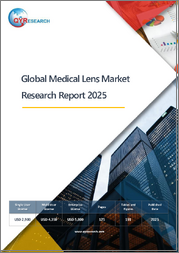
|
시장보고서
상품코드
1627628
콘택트렌즈 시장 : 예측(2025-2030년)Contact Lenses Market - Forecasts from 2025 to 2030 |
||||||
콘택트렌즈 시장은 CAGR 6.69%로 성장할 전망이며, 2025년 134억 800만 달러에서 2030년에는 185억 3,700만 달러 규모에 이를 것으로 예측됩니다.
세계의 콘택트렌즈 수요 증가의 주된 이유는 근시, 원시, 노안, 난시를 포함한 굴절 이상 발생률 증가입니다.
또, 고령화 사회의 대부분이 안질환을 안고 있기 때문에 안질환의 발생률이 상승하고 있는 것도 수요에 박차를 가하고 있습니다. 화장품 용도로 구매되는 화장용 렌즈와 컬러 렌즈 수요 증가로 인한 급성장 전망은 콘택트렌즈 시장 성장에 크게 영향을 미칩니다. 또한, 사람들은 더 활동적인 라이프 스타일을 보내기 때문에 안경 대신 콘택트렌즈를 착용하는 것을 선호합니다.
또, 콘택트렌즈는 프레임에 방해받지 않고 사용할 수 있는 기동성이 있는 등의 특징이 있어, 안경보다 뛰어난 선택지가 되고 있습니다. 게다가 액티브한 사람들의 라이프스타일 옵션으로 콘택트렌즈를 사용하는 경향이 강해지고 있습니다. 이 동향은 시장 진출기업에 의한 끊임없는 기술 혁신에도 박차를 가하고 있어 신제품 도입이 이 분야 수요를 높일 것으로 기대되고 있습니다.
콘택트렌즈 시장 성장 촉진요인
- 굴절 이상의 유병률 증가에 의한 렌즈의 보급률의 향상이 세계 콘택트렌즈 시장 성장에 기여
일반적인 안질환인 굴절 이상은 모든 연령대의 사람들에게 영향을 미치며 일반적으로 공중보건 문제로 인정받고 있습니다. 수많은 연구와 WHO의 보고서에 따르면 굴절 이상은 시각 장애와 시력 저하의 주요 원인입니다. 세계적으로 볼 때, 시력 장애는 증가하는 경향이 있으며, 그 주요 원인은 특히 어린이와 성인에서 근시와 노안의 이환율이 증가하는 것입니다.
WHO의 데이터에 의한 추계에 의하면, 2023년에는 약 22억 명이 근시가 되고, 또한 10억 명이 미교정의 굴절 이상에 의해 중등도 또는 중증의 시각장애, 혹은 실명이 된다고 하고 있습니다. 게다가 시력교정에 대한 의식은 국가나 지역 정부의 이니셔티브와 산업계 참가자들에 의해 세계적으로 높아지고 있습니다. 콘택트렌즈 시장은 이들에 의해 성장했습니다. 예를 들어, CooperVision은 미국에서만 약 4,500만 명의 렌즈 사용자가 있다고 보고합니다. 또한 NCBI는 2023년 세계에서 1억4천만 명이 렌즈를 사용하고 있음을 밝혔습니다.
콘택트렌즈 시장의 지리적 전망 :
- 북미는 예측기간 동안 비약적인 성장을 이룹니다.
북미는 가장 크고 가장 발전된 콘택트렌즈 시장 중 하나입니다. 강력한 건강 관리 시스템과 시력 교정 옵션에 대한 지식의 보급으로 이 지역은 미국과 캐나다로 구성됩니다.
콘택트렌즈 수요는 근시나 노안과 같은 시력 문제의 만연이 여전히 원동력이 되고 있습니다.
의료 용도뿐만 아니라 눈 색깔을 개선하거나 바꾸고 싶은 사람들은 화장용 콘택트렌즈를 자주 사용합니다.
이 보고서를 구입하는 이유
- 인사이트 있는 분석 : 고객 부문, 정부 정책 및 사회경제 요인, 소비자 선호도, 산업별 및 기타 부문 부문에 초점을 맞추어 주요 지역뿐만 아니라 신흥 지역도 다루는 상세한 시장 고려사항을 얻을 수 있습니다.
- 경쟁 구도 : 세계 주요 기업이 채택한 전략적 전략을 이해하고 적절한 전략으로 시장 침투 가능성을 이해할 수 있습니다.
- 시장 동향 및 촉진요인 : 역동적인 요인과 매우 중요한 시장 동향, 그리고 그들이 향후 시장 전개를 어떻게 형성해 나가는지를 탐색합니다.
- 실행 가능한 제안 : 역동적인 환경에서 새로운 비즈니스 스트림과 수익을 발굴하기 위한 전략적 의사 결정에 인사이트를 활용합니다.
- 폭넓은 이용자에 대응 : 신흥기업, 연구기관, 컨설턴트, 중소기업, 대기업에 유익하고 비용 효율적입니다.
기업은 어떤 목적으로 당사의 보고서를 사용하고 있는가?
업계 및 시장 인사이트, 사업 기회 평가, 제품 수요 예측, 시장 진출 전략, 지리적 확대, 설비 투자 결정, 규제 프레임워크과 영향, 신제품 개발, 경쟁의 영향
조사 범위
- 과거 데이터 및 예측(2022-2030년)
- 성장 기회, 과제, 공급망 전망, 규제 프레임워크, 고객 행동 및 추세 분석
- 경쟁 포지셔닝, 전략 및 시장 점유율 분석
- 부문 및 각국을 포함한 지역의 수익 성장 및 예측 분석
- 기업 프로파일링(특히 주요 개발)
목차
제1장 서론
- 시장 개요
- 시장의 정의
- 조사 범위
- 시장 세분화
- 통화
- 전제조건
- 기준연도 및 예측연도의 타임라인
- 이해 관계자의 주요 이점
제2장 조사 방법
- 조사 디자인
- 조사 과정
제3장 주요 요약
- 주요 조사 결과
- CXO의 시점
제4장 시장 역학
- 시장 성장 촉진요인
- 시장 성장 억제요인
- Porter's Five Forces 분석
- 업계 밸류체인 분석
- 애널리스트 보기
제5장 세계의 콘택트렌즈 시장 : 유형별
- 서문
- 소프트
- 경질 가스 투과성
- 하이브리드
- 기타
제6장 세계의 콘택트렌즈 시장 : 설계별
- 서문
- 구면 렌즈
- 난시용
- 다초점
- 기타
제7장 세계의 콘택트렌즈 시장 : 기간별
- 서문
- 매일 일회용
- 월간
- 6개월
- 연중
제8장 세계의 콘택트렌즈 시장 : 용도별
- 서문
- 교정
- 치료
- 화장품
- 기타
제9장 세계의 콘택트렌즈 시장 : 유통 채널별
- 서문
- 온라인
- 오프라인
제10장 세계의 콘택트렌즈 시장 : 지역별
- 서문
- 북미
- 유형별
- 설계별
- 기간별
- 용도별
- 유통 채널별
- 국가별
- 남미
- 유형별
- 설계별
- 기간별
- 용도별
- 유통 채널별
- 국가별
- 유럽
- 유형별
- 설계별
- 기간별
- 용도별
- 유통 채널별
- 국가별
- 중동 및 아프리카
- 유형별
- 설계별
- 기간별
- 용도별
- 유통 채널별
- 국가별
- 아시아태평양
- 유형별
- 설계별
- 기간별
- 용도별
- 유통 채널별
- 국가별
제11장 경쟁 환경 및 분석
- 주요 기업 및 전략 분석
- 시장 점유율 분석
- 합병, 인수, 합의 및 협업
- 경쟁 대시보드
제12장 기업 프로파일
- Bausch & Lamb Pvt. Ltd
- Zeiss International
- CooperVision
- Essilor International SA
- Hoya Corporation
- Johnson & Johnson
- SynergEyes, Inc.
- Alcon
- EyeMeditech Sdn Bhd
- Contamac
- Titan Eye
- Lenskart
- ContactsDirect
- CooperVision
- Ayers Eye Care
The contact lenses market is expected to grow at a CAGR of 6.69%, reaching a market size of US$18.537 billion in 2030 from US$13.408 billion in 2025.
The primary reason for the rising global demand for contact lenses is the increased incidence of refractive errors, which include myopia, hyperopia, presbyopia, and astigmatism.
The rising incidence of eye disorders also adds to this demand because most of the aging population has eye disorders. The rapidly growing prospects arising from an increase in demand for cosmetic and colored lenses, which are more often purchased for aesthetic purposes, greatly affect the market growth of contact lenses. In addition, people lead more active lifestyles, so they prefer to wear contact lenses instead of glasses; this applies mainly to athletes and some people who regularly engage in sports activities.
Moreover, contact lenses offer users features, such as broadened usage without the hindrances of frames and added mobility, making them a better option for glasses. Furthermore, active individuals have become increasingly inclined towards using contact lenses as a viable alternative to their lifestyle. This trend is also spurred by constant innovation by the market participants, with the introduction of new products promising to enhance demand in the sector.
Contact Lenses Market Drivers
- Increasing refractive error prevalence to increase lens penetration is contributing to the global Contact lens market growth
The common ocular disorder refractive error affects people of all ages and is generally recognized as a public health problem. Numerous studies and WHO reports stated that refractive error is the main cause of visual impairment and vision loss. Globally, vision impairment is also on the increase, mainly due to the increasing incidence of myopia and presbyopia, especially in children and adults.
According to an estimate given from WHO data, in 2023, about 2.2 billion people will be nearsighted, while an additional 1 billion will be moderately or severely visually impaired or blind due to an uncorrected refractive error. Moreover, awareness has grown for vision correction globally through national and regional governmental efforts and by industrial participants. The market for contact lenses grew on account of these. For instance, CooperVision has reported that there are around 45.0 million lens users in the US alone. Furthermore, NCBI revealed that 140.0 million people were using lenses globally in 2023.
Contact Lenses Market Geographical Outlook:
- North America is witnessing exponential growth during the forecast period.
North America is one of the biggest and most developed contact lens markets. With a strong healthcare system and widespread knowledge of vision correction options, the region comprises the United States and Canada.
The demand for contact lenses is still being driven by the prevalence of vision problems like myopia and presbyopia, which are partially caused by increased screen time.
In addition to medical applications, people who want to improve or alter the color of their eyes frequently use cosmetic contact lenses.
Reasons for buying this report:-
- Insightful Analysis: Gain detailed market insights covering major as well as emerging geographical regions, focusing on customer segments, government policies and socio-economic factors, consumer preferences, industry verticals, other sub- segments.
- Competitive Landscape: Understand the strategic maneuvers employed by key players globally to understand possible market penetration with the correct strategy.
- Market Drivers & Future Trends: Explore the dynamic factors and pivotal market trends and how they will shape up future market developments.
- Actionable Recommendations: Utilize the insights to exercise strategic decision to uncover new business streams and revenues in a dynamic environment.
- Caters to a Wide Audience: Beneficial and cost-effective for startups, research institutions, consultants, SMEs, and large enterprises.
What do businesses use our reports for?
Industry and Market Insights, Opportunity Assessment, Product Demand Forecasting, Market Entry Strategy, Geographical Expansion, Capital Investment Decisions, Regulatory Framework & Implications, New Product Development, Competitive Intelligence
Report Coverage:
- Historical data & forecasts from 2022 to 2030
- Growth Opportunities, Challenges, Supply Chain Outlook, Regulatory Framework, Customer Behaviour, and Trend Analysis
- Competitive Positioning, Strategies, and Market Share Analysis
- Revenue Growth and Forecast Assessment of segments and regions including countries
- Company Profiling (Strategies, Products, Financial Information, and Key Developments among others)
The contact lenses market is segmented and analyzed as follows:
By Type
- Soft
- Rigid Gas Permeable
- Hybrid
- Others
By Design
- Spherical
- Toric
- Multifocal
- Others
By Life
- Daily disposable
- Monthly
- 6-months
- Yearly
By Application
- Corrective
- Therapeutic
- Cosmetic
- Others
By Distribution Channel
- Online
- Offline
By Geography
- North America
- USA
- Canada
- Mexico
- South America
- Brazil
- Argentina
- Others
- Europe
- United Kingdom
- Germany
- France
- Italy
- Spain
- Others
- Middle East and Africa
- Saudi Arabia
- UAE
- Others
- Asia Pacific
- China
- Japan
- India
- South Korea
- Australia
- Others
TABLE OF CONTENTS
1. INTRODUCTION
- 1.1. Market Overview
- 1.2. Market Definition
- 1.3. Scope of the Study
- 1.4. Market Segmentation
- 1.5. Currency
- 1.6. Assumptions
- 1.7. Base and Forecast Years Timeline
- 1.8. Key Benefits to the Stakeholder
2. RESEARCH METHODOLOGY
- 2.1. Research Design
- 2.2. Research Processes
3. EXECUTIVE SUMMARY
- 3.1. Key Findings
- 3.2. CXO Perspective
4. MARKET DYNAMICS
- 4.1. Market Drivers
- 4.2. Market Restraints
- 4.3. Porter's Five Forces Analysis
- 4.3.1. Bargaining Power of Suppliers
- 4.3.2. Bargaining Power of Buyers
- 4.3.3. Threat of New Entrants
- 4.3.4. Threat of Substitutes
- 4.3.5. Competitive Rivalry in the Industry
- 4.4. Industry Value Chain Analysis
- 4.5. Analyst View
5. GLOBAL CONTACT LENSES MARKET BY TYPE
- 5.1. Introduction
- 5.2. Soft
- 5.3. Rigid Gas Permeable
- 5.4. Hybrid
- 5.5. Others
6. GLOBAL CONTACT LENSES MARKET BY DESIGN
- 6.1. Introduction
- 6.2. Spherical
- 6.3. Toric
- 6.4. Multifocal
- 6.5. Others
7. GLOBAL CONTACT LENSES MARKET BY LIFE
- 7.1. Introduction
- 7.2. Daily disposable
- 7.3. Monthly
- 7.4. 6-months
- 7.5. Yearly
8. GLOBAL CONTACT LENSES MARKET BY APPLICATION
- 8.1. Introduction
- 8.2. Corrective
- 8.3. Therapeutic
- 8.4. Cosmetic
- 8.5. Others
9. GLOBAL CONTACT LENSES MARKET BY DISTRIBUTION CHANNEL
- 9.1. Introduction
- 9.2. Online
- 9.3. Offline
10. GLOBAL CONTACT LENSES MARKET BY GEOGRAPHY
- 10.1. Introduction
- 10.2. North America
- 10.2.1. By Type
- 10.2.2. By Design
- 10.2.3. By Life
- 10.2.4. By Application
- 10.2.5. By Distribution Channel
- 10.2.6. By Country
- 10.2.6.1. USA
- 10.2.6.2. Canada
- 10.2.6.3. Mexico
- 10.3. South America
- 10.3.1. By Type
- 10.3.2. By Design
- 10.3.3. By Life
- 10.3.4. By Application
- 10.3.5. By Distribution Channel
- 10.3.6. By Country
- 10.3.6.1. Brazil
- 10.3.6.2. Argentina
- 10.3.6.3. Others
- 10.4. Europe
- 10.4.1. By Type
- 10.4.2. By Design
- 10.4.3. By Life
- 10.4.4. By Application
- 10.4.5. By Distribution Channel
- 10.4.6. By Country
- 10.4.6.1. United Kingdom
- 10.4.6.2. Germany
- 10.4.6.3. France
- 10.4.6.4. Italy
- 10.4.6.5. Spain
- 10.4.6.6. Others
- 10.5. Middle East and Africa
- 10.5.1. By Type
- 10.5.2. By Design
- 10.5.3. By Life
- 10.5.4. By Application
- 10.5.5. By Distribution Channel
- 10.5.6. By Country
- 10.5.6.1. Saudi Arabia
- 10.5.6.2. UAE
- 10.5.6.3. Others
- 10.6. Asia Pacific
- 10.6.1. By Type
- 10.6.2. By Design
- 10.6.3. By Life
- 10.6.4. By Application
- 10.6.5. By Distribution Channel
- 10.6.6. By Country
- 10.6.6.1. China
- 10.6.6.2. Japan
- 10.6.6.3. India
- 10.6.6.4. South Korea
- 10.6.6.5. Indonesia
- 10.6.6.6. Taiwan
- 10.6.6.7. Others
11. COMPETITIVE ENVIRONMENT AND ANALYSIS
- 11.1. Major Players and Strategy Analysis
- 11.2. Market Share Analysis
- 11.3. Mergers, Acquisitions, Agreements, and Collaborations
- 11.4. Competitive Dashboard
12. COMPANY PROFILES
- 12.1. Bausch & Lamb Pvt. Ltd
- 12.2. Zeiss International
- 12.3. CooperVision
- 12.4. Essilor International S.A.
- 12.5. Hoya Corporation
- 12.6. Johnson & Johnson
- 12.7. SynergEyes, Inc.
- 12.8. Alcon
- 12.9. EyeMeditech Sdn Bhd
- 12.10. Contamac
- 12.11. Titan Eye+
- 12.12. Lenskart
- 12.13. ContactsDirect
- 12.14. CooperVision
- 12.15. Ayers Eye Care



















